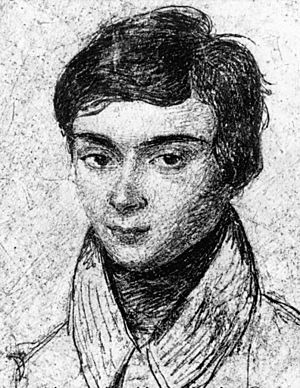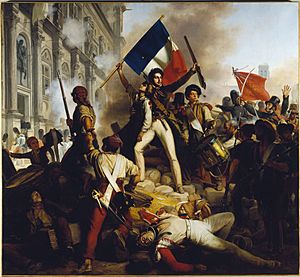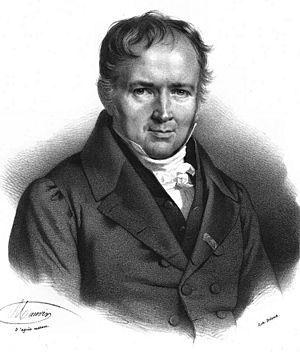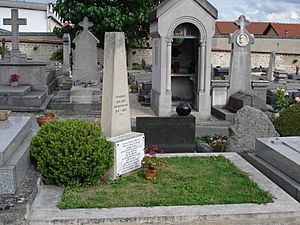Évariste Galois facts for kids
Quick facts for kids
Évariste Galois
|
|
|---|---|

A portrait of Évariste Galois aged about 15
|
|
| Born |
Évariste Galois
25 October 1811 |
| Died | 31 May 1832 (aged 20) Paris, Kingdom of France
|
| Cause of death | Gunshot wound to the abdomen |
| Alma mater | École préparatoire (no degree) |
| Known for | Work on theory of equations, group theory and Galois theory |
| Scientific career | |
| Fields | Mathematics |
| Influences | Louis Paul Émile Richard Adrien-Marie Legendre Joseph-Louis Lagrange |
| Signature | |
Évariste Galois (born October 25, 1811 – died May 31, 1832) was a brilliant French mathematician and a strong supporter of the republic. Even as a teenager, he solved a math problem that had puzzled experts for 350 years! He figured out when certain complex math problems, called polynomials, could be solved using basic math operations like roots.
His amazing work created the foundation for two important areas of abstract algebra: Galois theory and group theory. Galois was also very active in the political changes happening in France, especially around the French Revolution of 1830. Because of his political actions, he was arrested several times and even spent months in jail. Sadly, shortly after being released from prison, he was involved in a duel and died from his injuries.
Contents
Life of Évariste Galois
Early Years
Évariste Galois was born on October 25, 1811. His father, Nicolas-Gabriel Galois, was a Republican and led the liberal party in their village. He became mayor in 1814. Évariste's mother, Adélaïde-Marie, was very educated. She taught him at home until he was 12 years old. She was good at Latin and read many classic books.

In October 1823, Galois started at the Lycée Louis-le-Grand school. One of his teachers, Louis Paul Émile Richard, quickly saw how smart he was. When Galois was 14, he became very interested in mathematics.
He found a math book called Éléments de Géométrie by Adrien-Marie Legendre. People say he read it "like a novel" and understood it right away. By age 15, he was reading advanced papers by Joseph-Louis Lagrange, a famous mathematician. These papers likely inspired his later work on equations. Even though he was reading such difficult material, his schoolwork was not always great. His teachers sometimes thought he was too ambitious or tried to be too original.
A Young Math Genius
In 1828, Galois tried to get into the École Polytechnique, the best math school in France. He didn't prepare in the usual way and failed the oral exam because he didn't explain his ideas clearly enough. That same year, he joined the École Normale (then called l'École préparatoire). This school was not as good for math, but some professors there understood his talent.

In 1829, Galois published his first math paper about continued fractions. Around this time, he started making big discoveries about polynomial equations. These are equations with variables raised to different powers, like x² + 2x + 1 = 0. He sent two papers on this topic to the French Academy of Sciences. Augustin-Louis Cauchy, a very important mathematician, reviewed them. He didn't publish them right away. Many people have wondered why. However, it's now believed that Cauchy knew Galois's work was important. He just suggested combining the two papers into one for a big math competition. Cauchy thought Galois's work had a good chance to win.
On July 28, 1829, Galois's father died after a political argument. A few days later, Galois tried again to get into the Polytechnique, but failed again. Everyone agrees Galois was smart enough. Some say he made too many big jumps in his explanations, confusing the examiner. His father's recent death might have also affected him.
After not getting into the Polytechnique, Galois took other exams to enter the École Normale. He passed and got his degree on December 29, 1829. His math examiner wrote, "This student sometimes expresses his ideas unclearly, but he is intelligent and shows a remarkable spirit of research."
Galois tried several times to get his main work on equation theory published, but it never happened during his short life. After Cauchy's first refusal, Galois sent it to the Academy's secretary, Joseph Fourier, in February 1830. Sadly, Fourier died soon after, and the paper was lost. That year, the Academy's Grand Prize went to Niels Henrik Abel and Carl Gustav Jacob Jacobi. Even with the lost paper, Galois published three other papers that year. One of them laid the groundwork for Galois theory. Another was about finding solutions to equations. The third was important for number theory, introducing the idea of a finite field.
A Political Activist

Galois lived during a very unstable time in French politics. King Charles X was in power, but many people wanted more freedom. In 1830, Charles X tried to take away some rights, which started the July Revolution. This led to Louis Philippe becoming king. While students at other schools were fighting in the streets, Galois was kept inside his school by the director. Galois was very angry about this. He wrote a strong letter criticizing the director and sent it to a newspaper. Even though the newspaper didn't print his name, Galois was expelled from school.
Galois left school right away and joined a republican military group called the National Guard. He spent his time on both math and politics. The National Guard's artillery unit, which Galois joined, was soon disbanded because the government feared they might cause trouble. Around the same time, 19 officers from Galois's old unit were arrested for planning to overthrow the government.
In April 1831, these officers were found not guilty. On May 9, 1831, a celebration was held for them. Many famous people, like Alexandre Dumas, were there. The event became very lively. At one point, Galois stood up and made a strong statement about King Louis Philippe. The republicans there cheered, seeing it as a challenge to the king. He was arrested the next day and held in prison until his trial on June 15, 1831. Galois's lawyer argued that Galois's words were misunderstood. The jury found him not guilty that same day.
On Bastille Day (July 14, 1831), Galois was part of a protest. He wore his old military uniform and carried several weapons. He was arrested again.
Months later, on October 23, Galois had another trial. He was sentenced to six months in prison for illegally wearing a uniform. While in prison, he kept working on his math ideas. He was released on April 29, 1832.
Galois's Last Days

After being expelled from school, Galois went back to focusing on mathematics, though he still participated in political activities. In January 1831, he tried to teach an advanced algebra class, but his political work seemed to take priority. Siméon Denis Poisson, another famous mathematician, asked Galois to send him his work on the theory of equations. Galois did so on January 17, 1831. Around July 4, 1831, Poisson said Galois's work was "incomprehensible." He wrote that Galois's ideas were "neither sufficiently clear nor sufficiently developed." However, Poisson also encouraged Galois to publish his full work to get a final opinion.
Poisson's report reached Galois in prison in October. Given his personality and situation, Galois was very upset by the rejection. He decided not to publish his papers through the Academy anymore. Instead, he planned to publish them privately with his friend Auguste Chevalier. But Galois did follow Poisson's advice. He started gathering all his math papers while in prison and kept improving his ideas. After his release on April 29, 1832, he somehow got involved in a duel.
Galois's fatal duel happened on May 30. The real reasons for the duel are not fully clear. Many people have guessed why it happened. We know that five days before he died, he wrote a letter to Chevalier that mentioned a broken love affair.
Some old letters suggest the woman was Stéphanie-Félicie Poterin du Motel. She was the daughter of the doctor at the place where Galois stayed. Parts of her letters, copied by Galois, are still around. These letters hint that she told Galois about her problems, which might have made him start the duel to defend her.
As for his opponent, one writer, Alexandre Dumas, named Pescheux d'Herbinville. This person was one of the officers whose freedom was celebrated at the banquet where Galois was first arrested. But Dumas is the only one who says this. If it was true, it's unclear why d'Herbinville would have been involved. Some think he might have been du Motel's fiancé at the time. Other old newspaper reports describe his opponent as one of Galois's republican friends, possibly Ernest Duchatelet, who was in prison with Galois. Because of all the different stories, we may never know who his killer truly was.
Whatever the reasons for the duel, Galois was sure he was going to die. He stayed up all night writing letters to his republican friends. He also wrote what became his most famous math work, a letter to Auguste Chevalier explaining his ideas, along with three other papers. Mathematician Hermann Weyl called this work "perhaps the most substantial piece of writing in the whole literature of mankind." However, the story of Galois writing all his math ideas the night before he died might be a bit exaggerated. In these final papers, he added notes to his earlier work and polished his ideas.

Early in the morning of May 30, 1832, he was shot in the stomach. His opponents and his own helpers left him. A farmer found him. He died the next morning at ten o'clock in the Hôpital Cochin hospital, likely from an infection. He was only 20 years old. His funeral led to riots. Some people planned an uprising during his funeral, but it was postponed. Only Galois's younger brother knew about the events before Galois's death.
On June 2, Évariste Galois was buried in a common grave at the Montparnasse Cemetery. The exact spot is not known. In the cemetery of his hometown, Bourg-la-Reine, a memorial was built in his honor near his relatives' graves.
In 1843, Joseph Liouville reviewed Galois's papers and said they were correct. His most famous paper was finally published in 1846. This paper showed a new way to prove that there is no general formula to solve equations of the fifth degree (or higher) using only basic math operations and roots. This had been proven before by Niels Henrik Abel, but Galois's methods led to much deeper discoveries in what is now called Galois theory. For example, his work can tell us if any polynomial equation can be solved using roots.
Galois's Math Discoveries
Galois's collected works are only about 60 pages long, but they contain many important ideas. These ideas have greatly influenced almost all areas of mathematics. His work is often compared to that of Niels Henrik Abel, another mathematician who died young and whose work overlapped with Galois's.
Algebra
Many mathematicians before Galois thought about what we now call groups. But Galois was the first to use the word group in a way very similar to how mathematicians use it today. This makes him one of the founders of group theory, a part of algebra. He also introduced the idea of a finite field (also called a Galois field in his honor).
In his last letter to Chevalier and the papers he attached, Galois studied special types of groups called linear groups over finite fields:
- He described the general linear group and figured out how many elements it had.
- He also described the projective special linear group. Galois showed these groups were simple (meaning they couldn't be broken down into smaller groups) except for a few cases. These were the second type of finite simple groups discovered.
Galois Theory
Galois's most important contribution to math is his Galois theory. He realized that solving a polynomial equation using roots is connected to the structure of a group of permutations related to the equation's solutions. This group is called the Galois group. He found that an equation could be solved using roots if its Galois group had a special structure, called a solvable group. This idea was very powerful. Later mathematicians used it in many other areas of math, not just for solving equations.
Continued Fractions
In his first paper in 1828, Galois proved something about continued fractions. These are ways to write numbers as a series of fractions within fractions. He showed that if a certain type of number (a quadratic surd) is written as a continued fraction, the pattern in the fraction repeats perfectly if the number meets certain conditions.
He also showed that if you have one of these special numbers and its "conjugate" (a related number), their continued fractions have repeating patterns that are mirror images of each other.
From Galois's discoveries, a result already known to another mathematician, Lagrange, could be understood better. This result explains that if you take the square root of a number that isn't a perfect square, its continued fraction will have a repeating block where most of the numbers form a palindrome (reading the same forwards and backward).
See also
 In Spanish: Évariste Galois para niños
In Spanish: Évariste Galois para niños

